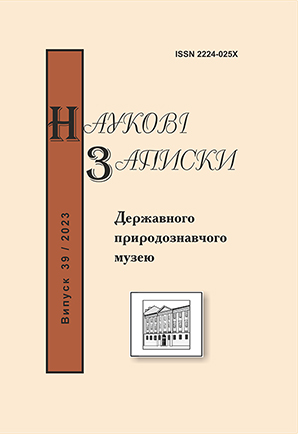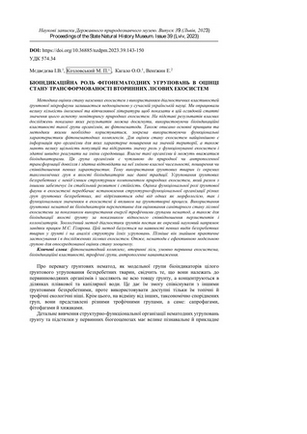Miedviedieva I., Kozlovsky M., Kagalo O., Węgrzyn Е. The bioindicator role of phytonematode groups in the assessment of the state of transformation of secondary forest ecosystems // Proc. of the State Nat. Hist. Mus. - Lviv, 2023. - 39. - P. 143-150 DOI: https://doi.org/10.36885/nzdpm.2023.39.143-150 Key words: structural and functional organization, primary ecosystem, nematode complex, trophic group The methodology for assessing the state of terrestrial ecosystems using diagnostic properties of soil microfauna remains underestimated in contemporary Ukrainian science. We have analyzed a significant amount of foreign and domestic literature to demonstrate the importance of this aspect in the overview article concerning the monitoring of natural ecosystems. Based on our own research results, we have shown the outcomes that can be achieved by utilizing the bioindicative properties of a specific group of organisms, such as phytonematodes. The fundamental principles and methodologies that should be applied, including using the functional characteristics of phytonematode complexes, have also been described. For evaluating the state of ecosystems, the most valuable information pertains to organisms that are widely distributed over a significant territory, have high population density, play a significant role in ecosystem functioning, and can rapidly respond to environmental changes. Organisms fitting these criteria can be considered bioindicators. This group of organisms is sensitive to natural or anthropogenic environmental transformations and can respond to them by altering their population density, distribution, or specific characteristics. Therefore, the use of soil animals from specific taxonomic groups as bioindicators has a long-standing tradition. Groups of soil invertebrates are integral structural components of natural ecosystems, together providing them with stable development and resilience. Assessment of the functional role of soil fauna in the ecosystem involves establishing the structural-functional organization of different groups of soil invertebrates, which differ both morphologically and functionally in the ecosystem and their impact on soil-forming processes. The use of soil nematodes as bioindicators is promising for evaluating the sanitary condition of forest ecosystems based on the indicator of energy utilization by trophic groups of nematodes, as well as for bioindication of soil quality based on the relative ratio of persisters and colonizers. The zoological method of soil diagnostics was established as a separate scientific direction thanks to the works of M.S. Gilyarov. This method is based on the presence of certain species of invertebrates in the soil and the analysis of the structure of their communities. Later, it found practical application in the research of forest ecosystems. Therefore, nematodes are an effective model group for the indirect assessment of the zoocenosis’ state.
References
- Голубець М.А. 2000. Екосистемологія. 316с.
- Козловський М.П. 2007. Біоіндикаційні властивості фітонематодних угруповань наземних екосистем Карпатського регіону. Дисертація доктора наук, Національна академія наук України Інститут екології Карпат. Львів. 395 с.
- Козловський М.П. 2009. Фітонематоди наземних екосистем Карпатського регіону. 48 с.
- Козловський М.П., Мєдвєдєва І.В. 2017. Структурно-функціональна організація фітонематодних угруповань ялини європейської у мішаних букових лісах Сколівських бескидів та її насадженнях. Наукові основи збереження біотичної різноманітності. Вип. 8. (15) C. 31-44.
- Мєдвєдєва І.В., Козловський М.П. 2020. Функціональна організація угруповань ґрунтових нематод ялини у первинних екосистемах. Вісник Сумського національного аграрного університету. “Агрономія і біологія”. Вип. 2 (40). C. 30-37.
- Мєдвєдєва І.В., Козловський М.П. 2022. Зміни фітонематодних угруповань ялини у вторинних екосистемах Сколівських Бескидів. Науково-практичний журнал. «Екологічні науки». Вип. 42. C. 168-174. DOI: https://doi.org/10.32846/2306-9716/2022.eco.3-42.28
- Парамонов А. 1952. Опыт экологической классификации фитонематод. С. 338-369.
- Риклефс Р. Основы общей экологии. М. : Мир, 1979. 424 с.
- Andrássy I. 1976. Evolution as a basis for the systematization of nematodes. Budapest : Akadémiai Kiadó. S. 288. Banage W.B. 1963. The ecological importance of free-living soil nematodes with special reference to those of moorland soil. J. Amin. Ecol. Vol. 32. P. 133–140.
- De Man J.G. 1884. Die Frei in der reinen Erde und im süssen Wasser Lebenden Nematoden der Niederlandischen Fauna. S. 206.
- Phillipson J., Abel R., Steel J., Woodell S. R. J. 1978. Earthworm numbers, biomass and respiratory metabolism in a beech woodland. Oecologia. Oxford : Wytham Woods. V. 33. S. 291–309.
- Yeates G.W. 1971. Feeding types and feeding groups in plant and soil nematodes. Pedobiologia. Vol. 11. Р. 173–179.
- Yeates G.W., Bongers T., DeGoede R.G.M., Freckman D.W., Georgieva S.S. 1993. Feeding habits in soil nematode families and genera – an outline for soil ecologists. J. Nematology. Vol. 25. Р. 315– 31.


